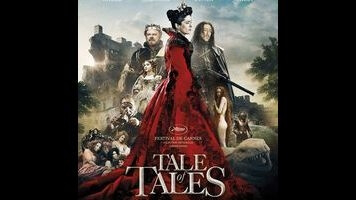Everything is ersatz and just a little off in the film, from the stiff staging of an undersea battle to the cut-rate digital effects to the preponderance of empty visual space. Whether or not the movie’s dialogue is intentionally stilted, it feels of a piece with the under-furnished castles and landscapes of scraggly rock that represent its three fairy-tale kingdoms; it sustains an air of otherness better than a sumptuous blockbuster could. Federico Fellini’s claustrophobic and alienated Casanova appears to be the main inspiration, with Alexandre Desplat’s score taking its cues from the ominous tinkling of Nino Rota’s music for the earlier film. Adapting a handful of stories from the 17th century fairy-tale collection The Tale Of Tales, Garrone aims for Casanova’s detached irony, creepy sexuality, and air of melancholy; he might not be Fellini, but at least he manages to pull off something more captivating than a run-of-the-mill Disney-fied bedtime story.
One story finds the debauched King Of Strongcliff (Vincent Cassel, doing his best impression of a wolf in a Tex Avery cartoon) falling head over heels for a voice, unaware that it belongs to an old spinster (Hayley Carmichael) who lives as a shut-in in a squalid dye shop. In another, the King Of Highhills (Toby Jones, typically superb) ignores his daughter to raise a flea to the size of a Shetland pony, only to end up with a cave-dwelling, man-eating monster for a son-in-law. There is a pair of albino twins (Christian Lees and Jonah Lees) born magically to different mothers, a mountain rescue performed by a troupe of traveling acrobats, a bizarre tournament of leather identification, a queen (Salma Hayek) who will do anything to get pregnant—all part of an allegory of unfulfillment that trades in left turns, cruel twists of fate, and uncomfortable laughs.
There is also creaky pacing, bad dialogue, and worse acting. But like the horrific internal logic of an authentic fairy tale, the film’s imperfections are part of what makes it unique. Would the black-robed sorcerer’s instructions to the queen be as memorable if the actor’s voice weren’t so poorly dubbed in? Does it matter if the sea monster looks convincing? Is John C. Reilly—who makes a brief appearance as the doomed, devoted King Of Longtrellis—giving the worst performance of his career, or is it a parody that’s in tune with movie’s caustic view of things? Fables are supposed to be indelible, and the least accomplished parts of Tale Of Tales leave more of an impression than many movies could at their best.


 Keep scrolling for more great stories from A.V. Club.
Keep scrolling for more great stories from A.V. Club.